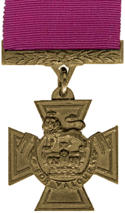John Schofield (VC)
John Schofield | |
|---|---|
 | |
| Born | 4 March 1892 Blackburn, Lancashire |
| Died | 9 April 1918 (aged 26) Givenchy, France |
| Buried | Vieille-Chapelle New Military Cemetery, Lacouture |
| Allegiance | |
| Service | |
| Rank | Second Lieutenant |
| Unit | |
| Battles / wars | World War I † |
| Awards | Victoria Cross |
John Schofield VC (4 March 1892 – 9 April 1918) was an English recipient of the Victoria Cross, the highest and most prestigious award for gallantry in the face of the enemy that can be awarded to British and Commonwealth forces.
Before joining up, he attended Arnold School in Blackpool. Numerous memorials to his actions during the war can be found in the school's foyer and a plaque commemorating his VC can be found outside the school's memorial hall, inside of which the names of all the fallen old boys can be found.
He was 26 years old, and a Temporary second lieutenant in the 2/5th Battalion, Lancashire Fusiliers, British Army during the First World War when the following deed took place for which he was awarded the VC.
On 9 April 1918 at Givenchy, France, Second Lieutenant Schofield led a party of nine men against a strong-point and was attacked by about 100 of the enemy, but his skillful use of men and weapons resulted in the taking of 20 prisoners. This officer, having made his party up to ten, then proceeded towards the front line, where he met large numbers of the enemy, on whom his party opened fire. He climbed on the parapet under point-blank machine-gun fire and by his fearless demeanor forced the enemy to surrender. As a result 123 of them, including several officers, were captured. He himself was killed a few minutes later.[1][2]
His Victoria Cross is displayed at the Fusilier Museum, Bury, England.
References
- ^ "No. 30770". The London Gazette (Supplement). 25 June 1918. p. 7618.
- ^ CWGC entry
- The Four Blackburn VC's (HL Kirby and RR Walsh)
- Monuments to Courage (David Harvey, 1999)
- The Register of the Victoria Cross (This England, 1997)
- VCs of the First World War - Spring Offensive 1918 (Gerald Gliddon, 1997)
- Use dmy dates from April 2012
- British World War I recipients of the Victoria Cross
- Lancashire Fusiliers officers
- British Army personnel of World War I
- People educated at Arnold School
- British military personnel killed in World War I
- 1892 births
- 1918 deaths
- People from Blackburn
- Royal Army Service Corps soldiers
- British Army recipients of the Victoria Cross
